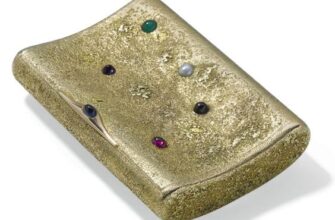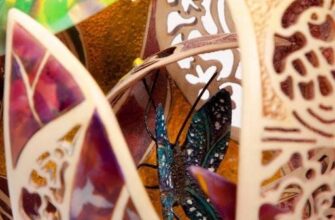Amber is pieces of the hardened resin of ancient trees that once fell into the water and therefore avoided rapid oxidation. There are more than a dozen "amber-bearing" regions in the world, the most famous (and widespread) amber is Baltic, but the most amazing inclusions (woody remains, arthropods and vertebrates included inside the resin) became famous Burmese amber - birmite (it bears the scientific name by the old name of the current Myanmar). The main center for its extraction is located in the state of Kachin on the border with China and India.
In general, amber from different regions was born at different times; Birmit has preserved for us animals that lived in the Cretaceous period, and, for example, the Baltic, Dominican and Mexican are many times younger. Rejoicing and surprising absolutely fresh finds. In 2016, even a feathered dinosaur tail was found in a piece of birmite, not to mention lizards, frogs and snakes.
Ammonite and Kо
However, dinosaurs are dinosaurs, and the current discovery surprised many: inside Burmese amber, an extinct cephalopod mollusk called ammonite (a distant relative of the current squid), 99 million years old, was discovered. This is the first ammonite and one of the very first marine organisms found in amber. (Of course, the vast majority of creatures found in petrified tree resin lived in forests, not in water, which is more than logical.)

The specimen in question was purchased by a Shanghai collector for about $750 from a dealer who claimed to have a land snail inside. However, X-ray computed tomography has made it possible to study the complex internal chambers characteristic of ammonites. And it is so well preserved that paleontologists confidently declare: it is a minor representative of the genus Puzosia.
Interestingly, the same three-centimeter piece contains at least four dozen other creatures - many ticks, spiders, centipedes, cockroaches, beetles, flies, wasps and marine gastropods. The corresponding article "An ammonite trapped in Burmese amber" by Professor Wang Bo from the Nanjing Institute of Geology and Paleontology of the Chinese Academy of Sciences and his colleagues from Europe and the United States was published on May 13 in PNAS.
To explain how all this richness got inside the amber, the researchers proposed three different scenarios: perhaps the resin dripped from a tree growing on the beach, or a flood (storm surge or even a tsunami) flooded the wooded lowlands, delivering sea creatures into pools of resin, or, finally, the storm wind just threw the shells into the forest.
Incomplete preservation and the absence of soft tissues of ammonite and marine gastropod mollusks (according to computed tomography, only sand fills the voids) suggest that these animals were not just dead at the time they got into the resin: they had already undergone decomposition on the seashore. In any case, the find turned out to be a pleasant surprise for paleontologists.
Whole snail
The first discovery of a 99-million-year-old snail with well-preserved soft tissue in a Burmite was reported in the journal Cretaceous Research at the end of last year. The found gastropod belongs to the cyclophorid family (Cyclophoridae), which still lives in this region. Before that, shells were found, but somehow the living snails did not get into the resin yet ... It remains to be hoped that someday we will come across a whole ammonite.
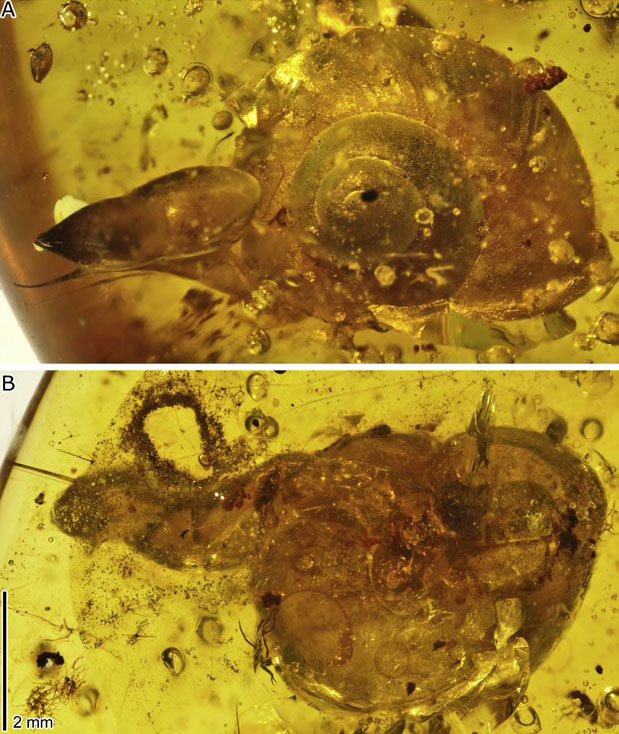
This is a very young individual only 6 mm long. Its slightly elongated shape apparently indicates attempts to free itself from the resin. Another snail (poorly preserved) was found in the same piece of amber.
The study was led by Xing Lida of China Geological University.
skeleton serpent
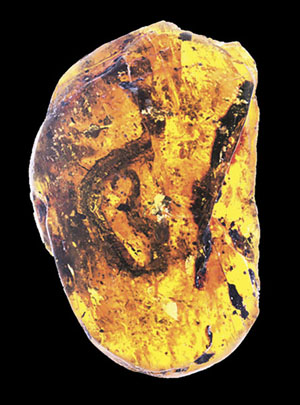
Reptiles are also found in amber. The skeletal remains of the most ancient 99-million-year-old serpent (along with fragments of plants) were first described a year ago.
In the late Cretaceous period, snakes already inhabited all continents. The Burmese find received a species name Xiaophis myanmarensis (this is a tribute to the amber specialist Jia Xiao and an indication of the place of the find - Myanmar). With the help of X-ray computed tomography, it was possible to examine almost a hundred articulated vertebrae with a total length of 5 cm. A dozen vertebrae of the caudal region, ribs and small areas of scales have also been preserved. About seventy more vertebrae and the actual skull, alas, are missing.
Ancient bird chick
Another exhibit - almost a whole carcass of a 99-million-year-old enanciornis bird chick - was found in a nine-centimeter piece of birmite. Two years ago, the results of the study of this piece of amber by computed tomography were published in the journal Gondwana Research. The find itself was made in the Hukon Valley in the northern part of Myanmar quite a long time ago, and in 2014 it was acquired by the director of the Chinese Amber Museum in Tengchong (Yunnan Province). The project to study this chick was again led by paleontologist Sin Lida (together with Canadian scientists).
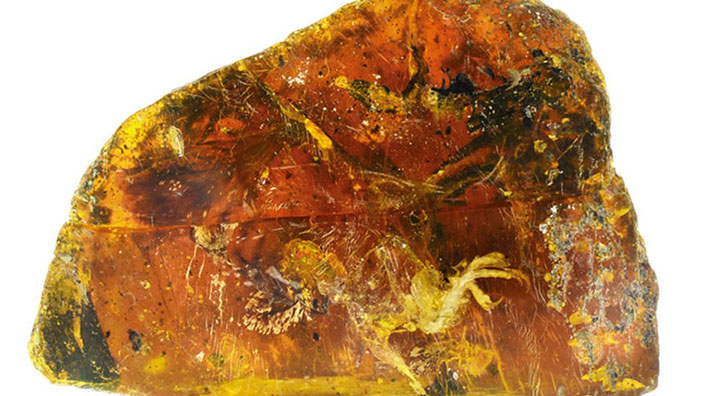
The preserved feathers indicate that the chick died during the first molt, when he was no more than a few weeks old. Interestingly, he could fly almost as soon as he hatched from an egg, which is not at all like most modern birds.
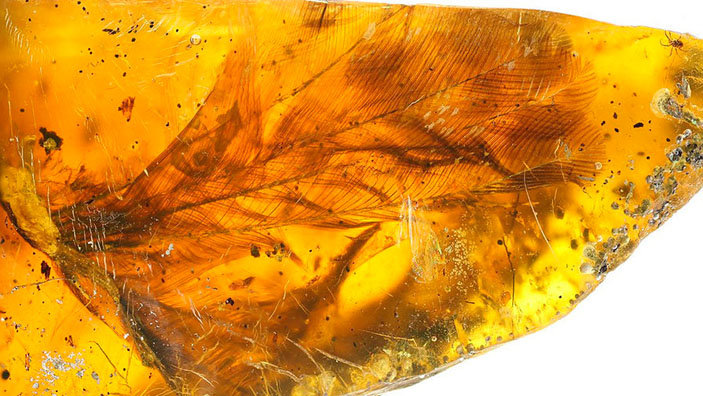
The reconstruction shows the chick in the position in which he accepted death, stuck in the resin. By simulating the process of molting, the researchers determined the color of the feathers - it varies from white and brown to dark gray, so paleontologists called the found chick Belone (Belone) - from the Burmese name of the local species of larks.
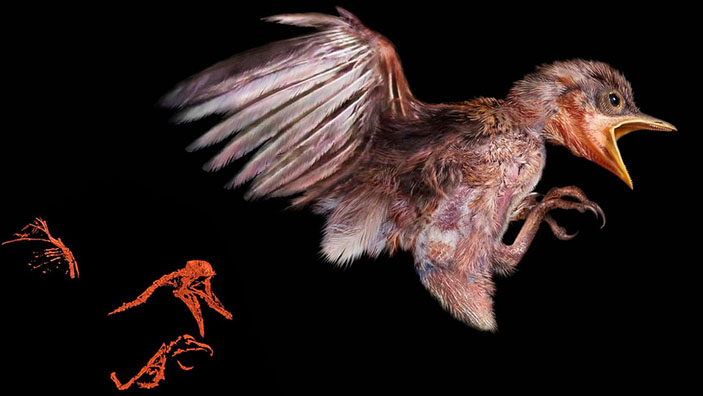
The cub belonged to one of the main groups of birds that once coexisted with dinosaurs and became extinct with them at the end of the Cretaceous period 65–66 million years ago, the so-called enantiornith birds. Their remains have been found on all continents, with the exception of Antarctica, over sixty species have been described. In the Cretaceous period, enanciornis birds successfully populated the then existing continents - Laurasia and Gondwana, and they got their name because of their "opposition" to modern (fan-tailed) birds (genus Enantiornis from the ancient Greek ἐναντίος - 'opposite' and ὄρνις - 'bird') - they are distinguished by the presence of teeth instead of a beak, and claws on the wings, and a humerus attached in the opposite, protracted position. The shell of the eggs of the enanciornis birds was distinguished by a strong three-layer structure.
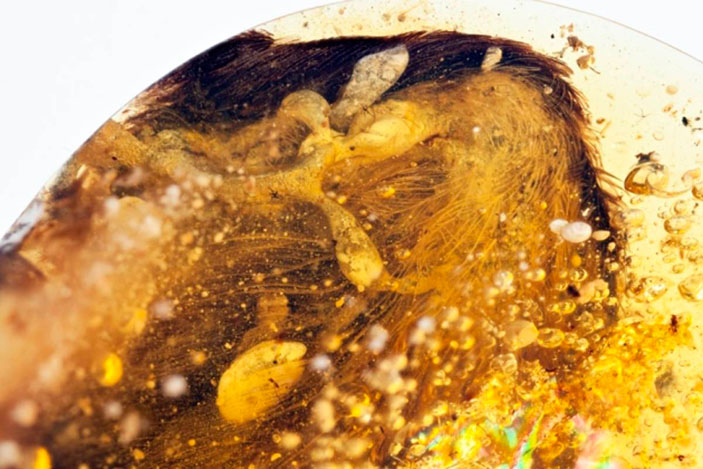
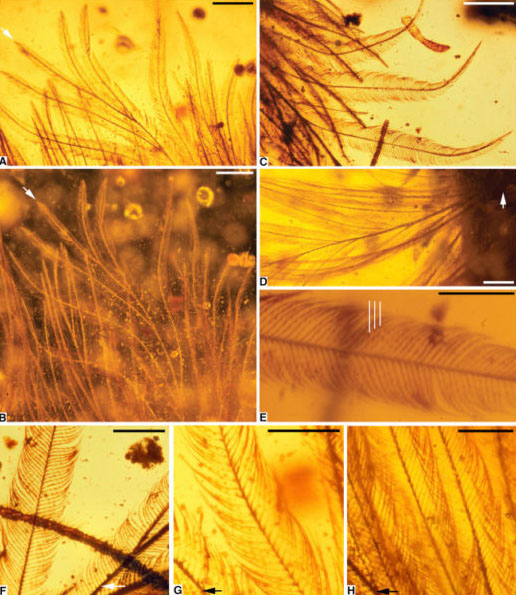
Separate fragments of enanciornis wings have already been found in amber, similar in structure to the flight feathers of modern birds. This baby also already had a full set of flight feathers, but its other plumage remained rare and looked more like the filamentous feathers of theropod dinosaurs, which do not have a clearly defined central shaft.
The presence of flight feathers on such a young bird actually confirms the thesis that enanciornis birds hatched immediately with the ability to fly. This advantage came at the price of a slow growth rate, which made these ancient birds more vulnerable over a long period of time, as evidenced by the fair number of juvenile enanciornis remains found in the fossil record (they are not comparable in number to any other young of any other bird genus). Cretaceous).
To a certain extent, enantiornithes are closer to feathered theropod dinosaurs, also covered with protofeathers (which, however, did not allow them to fly).
dinosaur tail
Several of the researchers who signed the previous article were also part of a group of scientists who made another high-profile discovery: in December 2016, a feathered dinosaur tail was reported, also in a 99-million-year-old piece of birmite from Kachin State.

The specimen was discovered by the attentive Xing Lida of China Geological University while visiting an amber market in Myanmar in 2015.

Insects, of course, add to this piece of “atmosphere” (a couple of ants and a beetle were also sealed in the resin of an ancient tree), but the main thing here is still a piece of the tail of some teenage theropod that has come off, probably belonging to the largest group of theropod dinosaurs - coelurosaurs (Coelurosauria). These are bipedal carnivorous lizards, which include the famous tyrannosaurs and velociraptors (the latter also belong to the maniraptors, which eventually turned into birds).
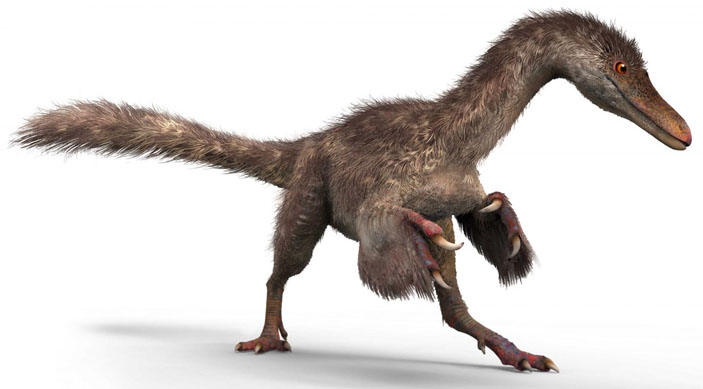
Of course, for some time dinosaur DNA was contained in this piece of amber (hemoglobin leaked out at the place of the cliff), but by our time all this has irreversibly disintegrated, so it is unlikely that it will be possible to revive dinosaurs (as in Jurassic Park). But it is possible to study some proteins by comparing them with those of modern birds to fill in some of the gaps in our understanding of avian evolution.
It is even more interesting to study dinosaur feathers in 3D and dream about the time when we will get a more tangible fragment of them.

